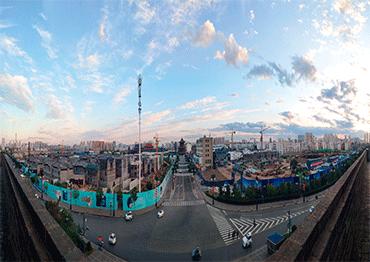Datong had already set its 12.5 billion yuan (US$1.84b) renewal project in motion when the official warning was handed down. All reconstruction projects came to a screeching halt.
Datong was spared with a three-year reprieve to make rectifications. “Datong is among the first top 24 National Famous Historical and Cultural Cities. This title is very important to us. It was the key starting point for Datong to transform from a coal mining city to a tourist and cultural city,” Chen said.
“That three-year rectification period was like getting a yellow card,” Chen said. “If we failed, a red card would be waiting for us.”
The southwest area of Datong is its most appealing historic district. It is where many of the city’s landmarks, like the Huayan Temple, the Catholic Diocese and Chunyang Palace, are or once were located.
Ma Bin grew up in the area and witnessed many ancient buildings vanish.
“When I was a kid, Xingguo Temple was my favorite place to play. Now it only exists in books,” Ma said. Built in 1916, Xingguo Temple was a large Buddhist temple in the south of the old city. In 1980, the local government tore it down to make room for modern buildings.
“Every 10 years Datong suffers serious destruction,” said Zhang Chengfu, an 83-year-old architect and scholar of the city’s residential courtyards.
In the 1950s, in order to improve traffic, the local government demolished the Haihui Hall of the Huayan Temple, the Bell Tower and the Four Archway Gates in the city’s center. During the Cultural Revolution (1966-1976), the city’s old South Gate and Wenchang Pavilion were torn down. In 1979, the South Gate, the city’s last gate, was demolished.
Though Datong had done serious damage to its historical heritage, the State Council still listed it among the first 24 National Famous Historical and Cultural Cities in 1983.
The most important reason, former professor of urban planning at Tongji University Ruan Yisan told NewsChina, was that the city’s ancient houses and streets were still intact in the 1980s. “Its historical value as an ancient capital of the Northern Wei Dynasty was just a secondary reason,” Ruan said.
“The honor had not raised awareness of the need to protect the city’s historic and cultural heritage. Instead, the wave of ‘constructive destruction’ became even fiercer after that,” Zhang Chengfu said.
The city wall of Datong was built in 1372, on top of the tamped clay walls from the Liao and Jin dynasties. At 7.34 kilometers long, the city wall enclosed the old city.
In the 1990s, about half the city wall was torn down. In 1998, the municipal government planned to replace all the traditional courtyards - mostly built in the Ming and Qing dynasties - with six-story apartment buildings.
Many other historical structures were destroyed afterwards. In a single project to redevelop Jiaochang Street and Dashizi Street in 1998, 7,154 houses were torn down and 4,259 families relocated.
That same year, Ma Bin’s courtyard home on Jiaochang Street was torn down. He moved to a newly built apartment.
“The demolition was mainly done by State-backed enterprises. The old houses were not worth a lot at the time. People all thought that new apartments were way better than old courtyards and houses. So the demolition was done extremely quickly,” Ma told our reporter.
An Dajun is president of the Datong Old Town Protection and Restoration Research Association. In 1998, An was elected as the Director of the Standing Committee of Datong Municipal People’s Congress, the city’s legislative body, and was active in historical protection legislation.
An strongly opposed the local government’s old city transformation plan. He argued fiercely with the city leaders, determined to stop the project. “I pounded on the table and almost smashed my tea cup out of rage,” An said.
The former legislator’s persistence eventually forced the local government to suspend the project. But by then Datong’s old city had already changed beyond recognition. Rows of monotonous six-story apartments were built, noticeably in the west of the city.
“The phenomenon of ‘constructive destruction’ was prevalent in China in the 1980s and 1990s during the development of its cities and towns. Most people, including decision makers, lacked awareness of historical and cultural heritage protection. They blindly destroyed the old and built new for the sake of development and improving people’s livelihood. But they knew nothing about how to protect our history and culture properly and caused irreversible losses,” Ruan Yisan said.

 Old Version
Old Version
